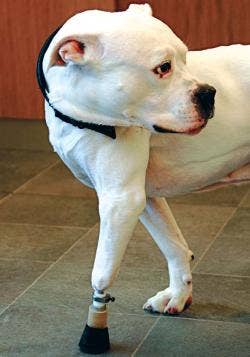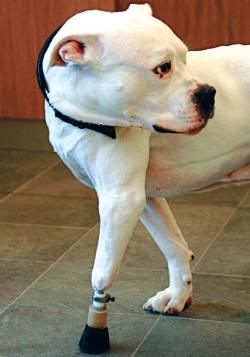Bionic Vet Headed to the US, Still Making Cyborg Pets in the UK (video)

Share
For just $3000 you can change your kitty into a cyber-cat. Noel Fitzpatrick, a veterinary surgeon in Surrey, England, made world news this summer when he grafted two prosthetic legs onto Oscar, a cat injured by a farm thresher. Fitzpatrick had performed single amputation replacements on dogs earlier, and continues to regularly install hip replacements and other artificial body parts into animals at his clinic. The success with Oscar and pets in similar situations earned Fitzpatrick his own documentary TV series, The Bionic Vet, which aired on the BBC for six weeks this summer. Now, he's heading to Chicago to help perform the first bionic pet operation in the US. ABC Nightline News in the US recently aired a segment about the pioneering veterinarian that highlights his obsession with transporting advanced surgical techniques from humans to animals and vice versa. Check out the video below. You have to love the old media corniness of the title - "A New Leash on Life".
Fitzpatrick has made some real advancements in prostheses during his animal surgeries. He developed intraosseus transcutaneous amputation prostheses (ITAPS), an umbrella like device that fits over the stump left behind after amputation. Unlike many prostheses, ITAPS has a special texture that allows skin and other tissue to grow into the metal. Not only does this make the device more secure, it also reduces the risk for infection. One also assumes it's less irritating, but we'll have to wait until the first human has one installed before we know for sure. That should be coming soon - at least one person, a woman injured in the 2005 London bombings, is set to receive an ITAPS device. It will be interesting to see if ITAPS, and other techniques that Fitzpatrick has developed, will gain popularity among medical surgeons. As you can see in the video below, the Bionic Vet certainly believes in the importance of his work. He's probably right. As Fitzpatrick mentions, medical techniques are tested on animals first anyways, so it shouldn't be so surprising that veterinarian science has a lot to teach human surgery. We may already be developing advanced robotic limbs for humans, but we can still benefit from learning how to attach them more securely. And come on, how can you ignore someone named the Bionic Vet? Too cool.
Be Part of the Future
Sign up to receive top stories about groundbreaking technologies and visionary thinkers from SingularityHub.


Related Articles

Single Injection Transforms the Immune System Into a Cancer-Killing Machine

This Light-Powered AI Chip Is 100x Faster Than a Top Nvidia GPU

This Week’s Awesome Tech Stories From Around the Web (Through December 20)
What we’re reading
